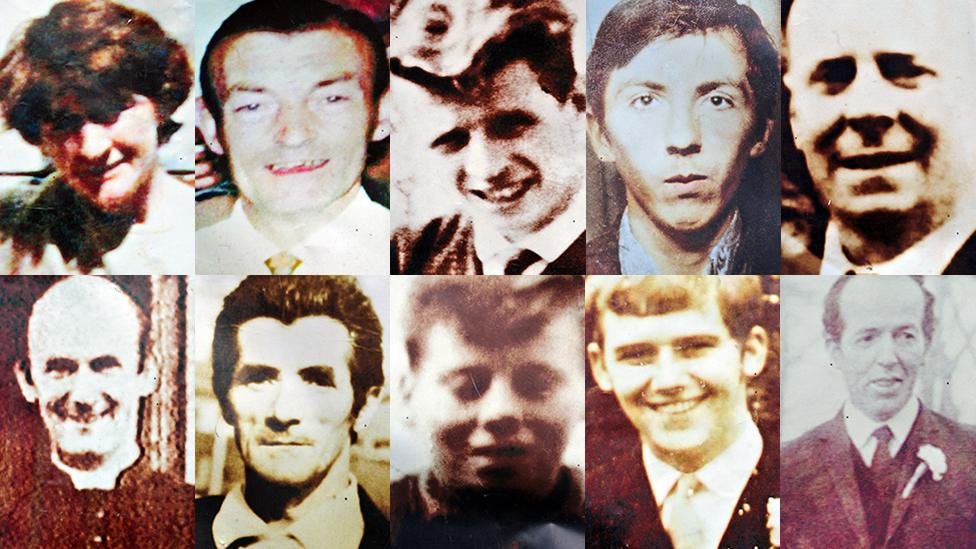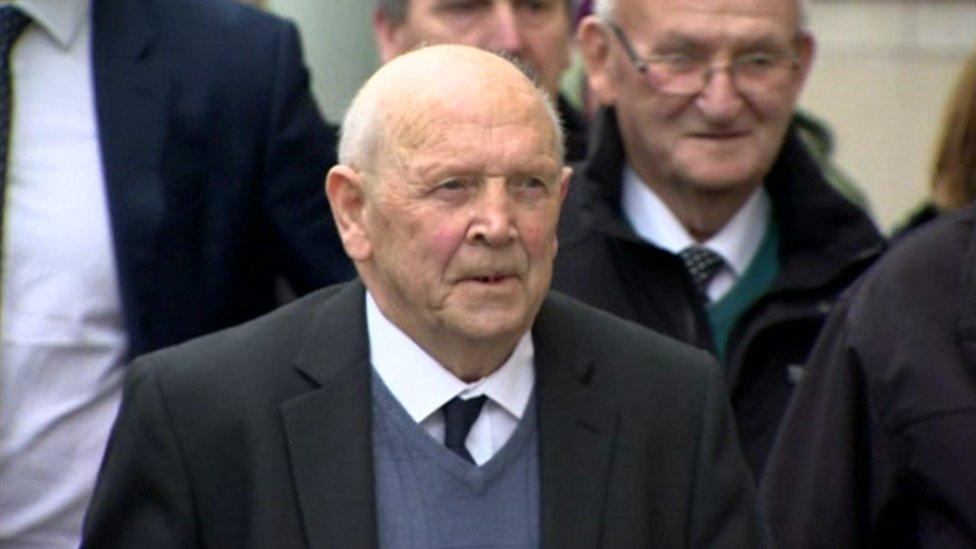Ballymurphy Inquest hears there were armed civilians in area
- Published

Nine men and a woman were killed in Ballymurphy in August 1971
The Ballymurphy Inquest has heard how a man saw civilians with shotguns and others with pistols in the general area before and after several men were shot.
Gerald Clarke gave evidence to the inquest which is examining 10 deaths in the wider area over three days.
He believes Fr Hugh Mullan, 38, and Francis Quinn, 19, died from shots fired by the army - not civilians.
Mr Clarke insists no-one on the waste ground where they died produced or discharged a firearm.
Mr Clarke is the younger step-brother of Bobby Clarke, who gave evidence on Tuesday.
Gerald Clarke described the unrest around his home in Springfield Park earlier in the day, when he says crowds from Springmartin attacked the area, and some local people tried to defend it.

Fr Hugh Mullan and Francis Quinn were shot behind Springfield Park
He told the court he observed people with a shotgun on more than one occasion, but is unsure how many there were.
At one point he said someone handed him a shotgun and cartridges, before two men quickly took them from him.
He also remembers seeing someone he knew to be an IRA man fire a pistol, whilst facing towards a crowd at Springmartin.
At another stage Mr Clarke said he saw men in the Moyard area with a shotgun at some garages, but they failed to get the weapon to fire.
He told the court he could not remember making statements at an inquest in 1972 which described other gunmen.
Close to death
Later that day, he said, he observed his brother Bobby being shot and falling on the waste ground beside Springfield Park.
Gerald Clarke then gave a detailed account of the hours after his brother Bobby was shot.
He had run to where he lay as another man bandaged Bobby's wound.
Gerald Clarke said he left briefly to help some women and children escape across the area, and on his return a man was lying beside his brother.
He says he lay down with his head at the feet of the man he now knows to have been Francis Quinn.

Who were the victims?
Father Hugh Mullan, 38, and Francis Quinn, 19, were shot in an area of open ground behind Springfield Park
Daniel Teggart, 44, Joan Connolly, 44, Noel Phillips, 19, and Joseph Murphy, 41, were shot near the Henry Taggart Army base near Springfield Park
John Laverty, 20, and Joseph Corr, 43, were shot at separate points at the top of Whiterock Road
Edward Doherty, 31, was shot at the corner of Brittons Parade and Whiterock Road
John McKerr, 49, was shot outside the old Corpus Christi Parish

"The shooting of bullets was amazing," he said.
"You were that close to death."
He watched Fr Mullan start to leave after talking with Bobby Clarke.
He described a burst of gunfire and Fr Mullan being hit and crying out in agony.

Bobby Clarke gave evidence to the inquest on Tuesday
Later a shot hit Frank Quinn in the head, he said, and the body recoiled, Mr Quinn's feet kicking him in the head.
Gerald Clarke says he lifted himself up, saying, "are you dead, are you dead?" before he realised he was now a target, and getting down again.
He knew at that moment, he said, that Frank Quinn was dead.
'Recall sound of bullets'
Mr Clarke told the court he has found recalling the events very traumatic recently, having locked them away.
He said: "See cowboy films? See war films? They're not real. This was real."
Against his will, he said, he could recall the sound of bullets hitting people.
He told the court that shooting came from soldiers on the roof of the nearby Springmartin flats, with the distinctive sounds of high velocity Self-Loading Rifle (SLR) shots.
He described waiting until dark with his brother Bobby and hearing other gunshots from a different direction, and from a different weapon.
Later they tried to crawl away to safety.
At this point he remembers them being helped out of the waste ground by a third man, whom he recognised as a member of the IRA.
Mr Clarke said at one stage this man produced a pistol.
He told the court he did not see him fire the weapon.
Later in the hearing it was agreed that Gerald Clarke would provide the names of the IRA figures he had recognised to the coroner.
Mr Clarke denied a suggestion by a barrister for the Mullan and Quinn families that his account of events "had got better in the recollection".
He insisted that his memories of that day were correct, and that the events he described had indeed taken place.
- Published12 February 2019

- Published11 February 2019

- Published7 February 2019

- Published5 February 2019

- Published11 May 2021
